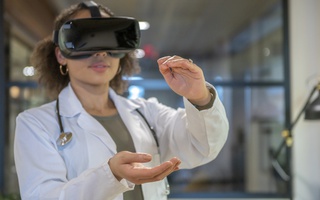Advantages and features of software solutions in supporting digital production, preparation of an enterprise for implementation of PLM-system, need of Russian companies for digitalization – these are the topics we discussed with Viktor Bespalov, Vice President and General Manager of Siemens PLM Software in Russia and CIS
— Viktor, what role does Siemens PLM Software expect to play in implementing basic concept of digital production?
— Siemens takes on several important roles at once.
First, Siemens presents itself both as one of the principal ideologists of the digital production concept and a strategic thinker that determines its development trends. We do understand why this concept is required, and how to apply it in various industries. Automotive industry may be given as an example where the advantages of digital production are most visible. It is mass production, on the one hand, and customer tailored products, on the other. The concept of digital production is the most sought-after in such an environment.
Second, we act as a technology provider. As a developer, Siemens offers to its customers the technologies designated not only for the virtual products, but also for the physical production, since digital production must be supported both by software solutions and such industrial automation tools, as transducers, controllers, sensors, and other similar equipment.
And third, we act as users, as we apply digital production technologies within our company. We test everything on our own, thereby demonstrating all the advantages, which can be gained by our customers as well. First digital factories were implemented right by Siemens. Our most famous example is the factory in Amberg, where the process of developing and manufacturing of industrial controllers is arranged using the ideology of digital production. It is almost peopleless enterprise, where robots perform 75% of operations.
— How fast, in your opinion, the IT maturity of Russian business develops? How do you assess the level of business process automation and quality of data operated by industrial companies?
— In automation, Russia follows the same way as the majority of developed countries, which are yet significantly ahead of our country in terms of GDP per capita. However, the IT maturity of our companies is developing quite fast.
Development gap is uneven and differs significantly in various industries. Think, for instance, of the automotive industry, where the workforce productivity is lower in the Russian Federation than abroad, the rate of manual labor is still high, whereas the level of automation is still low. Instead, engineering and design institutions engaged in development of equipment for aviation industry may boast of the high automation level. At the same time, this level may be different even within one and the same large holding company. This, to the great extent, is caused by the fact that the lead lime of development and production is quite long in automotive and aviation industries, and innovations come with new products only.
Still, what is most important is that Russian companies are generally aware of the need for changes. For example, the largest manufacturer of heavy trucks – KAMAZ company – has already announced its strategy to develop towards Industry 4.0 and already begun to implement such a project. Similar approach is observed among such KAMAZ competitors, as Iveco, Volvo, Daimler, etc. Everyone understands that to lead any market segment, appropriate automation is required, and the level of such automation is determined by the range of new products launched by our customers.
— How to get the business prepared for the implementation of PLM?
— An ideal way is to create an enterprise from scratch through building new production lines based on the up-to-date principles and technologies. But there are no such examples in practice. Most often, it is required to create new products based on the existing production lines through their modernization.
In case of a large-scale PLM, the works on its implementation are performed at the same pace as the development of a new future product. Thus, where the target is to achieve a higher level of the PLM system within the frames of the aviation program, it should be developed simultaneously with the development of the aircraft program, and, ideally, be a bit ahead in order to adapt new technologies and development methods not pointwise, but on an industrial scale.
— Is it worth to change all the processes in various functional areas at once?
— It’s not necessary. There are plenty of examples of an “evolutional” approach. It is possible to move gradually accumulating qualitative changes, which further may become quantitative ones. For example, an enterprise buys modern equipment first, then introduces new manufacturing processes, after which the time comes to train design departments and to bring information about the equipment capabilities to their specialists, who will apply them in future for the design engineering or modification.
— Siemens portfolio includes both all-purpose projects applied in all sectors and sector-specific solutions. Please tell us how did you accomplish this and how does it help your customers?
—Over the past 10 years, Siemens has invested, on a conservative estimate, about 12 billion euros in the purchase of products and technologies, which are often specific to a particular industry. Recent merger of Siemens PLM Software and Mentor Graphics has changed a lot. Before Siemens was a player at the mechanical engineering market and offered only individual solutions for the electronics industry. Now its portfolio is supplemented with solutions for electronics and microelectronics. Owing to the deal on acquisition of Polarion, Siemens has expanded its footprint in the growing market of ALM (solutions for the analysis of software life cycle management processes) and continued to improve its tools for creating smart products managed by software systems.
Acquisition of TASS International (a global provider of computing simulation software) supplemented Siemens portfolio of CAE solutions with technologies and applications specific to the automotive industry. They make it possible to develop ADAS (Advanced Driver Assistance System) to assist drivers in driving vehicles owing to built-up safety systems, advanced assistance and hands-off driving systems, as well as tools for simulating behavior of wheels on the road.
Today, Siemens is a company that offers the world-widest range of design and engineering solutions to its customers.
— Which of industrial automation projects implemented by Siemens could be mentioned as the most interesting and unique?
—One of our objectives is to transform something unique into mass one. In this regard, the flagship projects, which plot a vector for the development, are of the greatest interest. Such projects may be called breakthrough, since they directly anticipate the Fourth Industrial Revolution. These are the projects connected with additive manufacturing, big data for operational analysis, bionic design, and system engineering. All such technologies have already found the widespread industrial use, and this trend is observed in Russia and throughout the world. For example, the system engineering elements were used to create a model of the most advanced short- and medium-range passenger aircraft Irkut MS 21.
Additive manufacturing that makes it possible to change design of the products and processes associated with their servicing, and to significantly save on raw materials, provide businesses with tremendous advantages.









